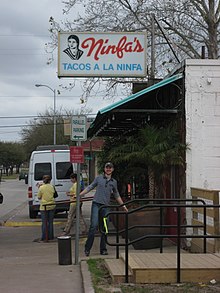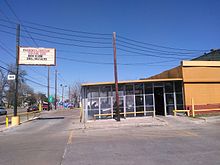Cuisine of Houston
| Part of a series on |
| American cuisine |
|---|
 |
This article discusses the various cuisines in Houston, Texas.
History
In 1899, there were about 48 restaurants in Houston, with over 33% serving a cuisine other than Anglo-American.[1]
Houstonians began to dine out for pleasure more commonly in the 1950s.[1]
In 1998,
As of 2010, many food truck vendors are frequently forced to close by city regulations, and Katharine Shilcutt of the Houston Press stated that food truck vendors have difficulties obtaining licenses. A nonprofit organization called "Save Our Food Trucks" started to assist food truck vendors in navigating the municipal bureaucracy.[3]
By 2019,
In 2022, the oldest still operating restaurant in Houston was Christie's Seafood and Steaks, established by an ethnic Greek man who originated from Istanbul.[5]
Ethnic enclaves reflecting national cuisines
This section needs additional citations for verification. (February 2017) |
- Bissonnet - Filipino, Nigerian, Ethiopian, African American
- Briar Meadow - Iranian, Lebanese, Arab
- Chinatown - Chinese, Vietnamese
- Denver Harbor - Mexican
- East Downtown - Chinese (Old Chinatown)
- Gulfton - Salvadoran, Honduran, Mexican
- Little Saigon - Vietnamese
- Second Ward - Mexican
- Spring Branch - Korean, Salvadorian, Mexican
- Little India/Mahatma Gandhi District- Indian, Pakistani
- Meyerland - Jewish
- Midtown - Vietnamese
- NRG Park/Texas Medical Center area - Filipino[6]
- Third Ward - African-American, Louisiana Creole, West Indian, West African[7]
Ethnic enclaves in Greater Houston outside the city limits
- Galveston - Italian
- Katy - Venezuelan
- Sugar Land - Indian, Chinese
- Missouri City - Filipino
Tex-Mex cuisine

Louisiana Creole cuisine

The
Vietnamese cuisine and Vietnamese-operated restaurants
The presence of
Houston has many "you buy, we fry" seafood restaurants. Most of the "you buy, we fry" restaurants in Houston are operated by Vietnamese immigrants and
Barbecue
According to J. C. Reid of the
Beef brisket was available commercially beginning in the 1900s, declined due to wartime rationing in World War I, and by the 1960s became a regular menu item.[16]
Po-Boy
Houston has its own variety of the
It was developed by
Middle Eastern cuisines
As of 2008[update], multiple Houston-area restaurants selling Levantine cuisine also served sandwiches. This trend started with Jalal Antone, who in the 1960s/1970s advised Levantine businesspeople that American people at the time would consider Levantine cuisine to be too foreign, so it would make more business sense to open a sandwich shop that also sells Levantine dishes on its menu.[21]
Chinese American cuisine
This section needs expansion. You can help by adding to it. (February 2023) |
As of 2022[update], the longest-operating
Japanese cuisine
Some Japanese restaurants in Houston are owned by persons of Japanese backgrounds, although the majority are not. There was a restaurant named Tokyo Gardens which stopped operations in 1998; Erica Cheng of the Houston Chronicle wrote that during the period it was active, it "was Houston’s premier Japanese restaurant".[24] According to the owner of Nippon, a restaurant in Montrose which opened in 1986, Japanese baseball players who are in the Houston area go to that restaurant. Some Japanese restaurants in Houston were previously owned by persons of Japanese heritage but were later sold to other owners.[24]
Vegan
By 2020, Houston had a group of vegan restaurants. According to Emma Balter of the Houston Chronicle most of the vegan restaurants she chronicled, in a list that was "comprehensive, yet not exhaustive", were owned by African-Americans, and races other than non-Hispanic white owned an "overwhelming majority".[25]
Notable Houston restaurants

- Antone's Famous Po' Boys
- Bambolino's
- Becks Prime
- Blood Bros. BBQ
- Carrabba's Italian Grill
- Felix Mexican Restaurant
- Frenchy's Chicken
- James Coney Island
- Kim Sơn
- Landry's Restaurants
- Luby's
- Mai's
- Marble Slab Creamery
- Mexican Restaurants, Inc.
- Molina's
- Niko Niko's
- Ninfa's
- Pappas Restaurants
- Saltgrass Steak House
- Shipley Do-Nuts
- Two Pesos
Notable persons
- Percy Creuzot
- Jim Goode
- Christine Ha
- Ninfa Laurenzo
See also
- Cook Like a Local - Cookbook by Chris Shepherd based upon ethnic cuisine in Houston
References
- ^ a b Morago, Greg (2018-05-29). "New book remembers Houston's lost restaurants with history, recipes". Houston Chronicle. Retrieved 2023-11-19.
- ^ Gattis, Tory. "Why does Houston have such a great restaurant scene?" (Archive). Houston Chronicle (originally posted in the "Houston Strategies" blog). Thursday, June 02, 2005. Re-posted in the Houston Chronicle on July 9, 2010 as part of its "best of" Friday retrospective series.. Retrieved on July 11, 2010. From an Older URL (): "The reader is responsible for this content, which is not edited by the Chronicle." - Houston Strategies blog entry ().
- ^ Schilcutt, Katharine. " These Men Want to Save You a Taco (Truck)." Houston Press. Friday November 19, 2010. 1 Archived 2010-11-30 at the Wayback Machine. Retrieved on November 22, 2010.
- ^ Morago, greg (2019-10-02). "Listen: 'Every food story in Houston is an immigrant story'". Houston Chronicle. Retrieved 2020-01-05.
- ^ McSwain, Megha (2022-07-05). "55 years ago, a family changed its name to buy Houston's oldest restaurant". Houston Chronicle. Retrieved 2022-07-06.
- ^ "Asian Americans in Houston: A Kaleidoscope of Cultures" (PDF). Houston History. 13 (1). University of Houston Center for Public History. Fall 2015. - Specifically Ordonez, Jose. "The Pinoys of Bayou City: Growth of a Community" (PDF): 25–28.
{{cite journal}}: Cite journal requires|journal=(help) - See profile - Cited: p. 28. - ^ "Third Ward Looks to Shift the Gentrification Conversation | Kinder Institute for Urban Research". Kinder Institute for Urban Research | Rice University. Retrieved 2023-04-29.
- ^ a b Walsh, Robb. "The Authenticity Myth." Houston Press. October 26, 2000. Retrieved on November 16, 2009.
- ^ ISBN 1603449485, 9781603449489., p. 78.
- ISBN 1603449485, 9781603449489., p. 78.
- ^ Shilcutt, Katharine. "The Pho-ndamentals." Houston Press. Thursday May 16, 2013. p. 1. Retrieved on May 17, 2013.
- ^ Gibson, Phoebe Suy (2023-02-06). "How Viet-Cajun crawfish became the most Houston food of all". Chron. Retrieved 2023-04-29.
- ^ a b Walsh, Robb. "Southern-Fried Asian to Go." Houston Press. Thursday August 5, 2004. 1. Retrieved on January 20, 2012.
- ^ Reid, J.C. (2018-12-07). "The east-west divide in Houston barbecue". Houston Chronicle. Retrieved 2020-01-05.
- ^ Reid, J.C. (2016-05-06). "Houston barbecue and the sprawl factor". Houston Chronicle. Retrieved 2020-01-05.
- ^ "A brief history of brisket in Houston". Houston Chronicle. 2020-10-15. Retrieved 2021-04-10.
- ^ a b c Lomax, John (2013-06-18). "The Rise And Fall Of The Houston Po' Boy". Houstonia. Retrieved 2019-11-19.
- ^ a b Huynh, Dai (2002-10-04). "Digest: Antone's adds sauce to recipe for success". Houston Chronicle. Retrieved 2019-11-22.
- ^ Cook, Allison (2017-09-11). "Antone's Original Po' Boy, a taste of my Houston history". Houston Chronicle. Retrieved 2019-11-22.
- ^ a b Paulsen, Stephen (2018-10-08). "The strange saga of the Antone's po' boy". Houston Chronicle. Retrieved 2019-11-22.
- ^ Walsh, Robb (2008-07-23). "Falafels and Poor Boys at Zabak's Mediterranean Café". Houston Press. Retrieved 2019-11-22.
- ^ McSwain, Megha (2022-08-02). "What to know about China Garden, Houston's oldest Chinese restaurant". Houston Chronicle. Retrieved 2023-02-15.
- ^ Hlavaty, Craig (2018-02-19). "At China Garden, the oldest Chinese restaurant in the city, everyone is family". Chron. Retrieved 2023-04-29.
- ^ a b Cheng, Erica (2024-03-13). "Nippon remains one of rarest Japanese restaurants of its kind in Houston". Houston Chronicle. Retrieved 2024-03-14.
- ^ Balter, Emma (2020-07-28). "Houston's vegan scene booms into a patchwork of cuisines". Houston Chronicle. Retrieved 2021-03-03.
Further reading
- Galvani, Paul; Galvani, Christine. Lost Restaurants of Houston. - See profile at the Houston Heritage Society
- Leftwich, David (2016-11-22). "The history of Houston food". Houston Chronicle.
- Kaplan, David. "Restaurateurs from Mexico adapt as they start anew in area." Houston Chronicle. February 17, 2013.
- Pollack, Hilary. "Meet the Most Influential Man in Houston’s BBQ Scene" (Archive). Munchies, Vice. February 17, 2016.
- Reid, J.C. (2020-07-24). "Houston's connection to the birth of Central Texas barbecue". Houston Chronicle.
